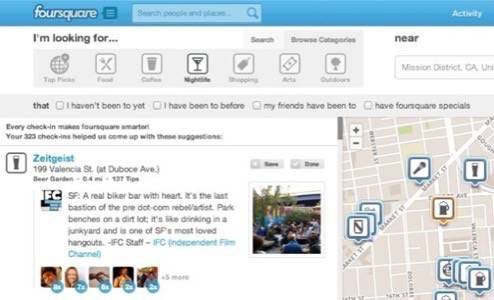

On the face of it, the statistics are impressive: 20 million registered users and 2 billion check-ins. But as location check-in app Foursquare celebrates 4sqDay (16 April = 4 squared, geddit?), how many people still regularly use the service? After all, manually checking in to places is going out of fashion isn’t it? Aren’t next generation location apps like Highlight and Glancee the New New Thing in location? What’s more, Instagram grew faster than Foursquare and it is, in a sense, a location app too (you typically take photos when out and about). So is Foursquare really as popular as the statistics the company released today suggest?
I’ve given Google+ grief over how active its millions of registered users are. It seems to me the same question should be asked of Foursquare. Particularly because many of Foursquare’s original users (this author included) have drifted away from the service over the past year. Foursquare doesn’t release active user numbers, probably for the same reason Google+ doesn’t: it’s likely a small percentage of registered users.
There is another reason to question Foursquare’s active user base: it has done a mini-pivot. Last year Foursquare released a mobile feature called Explore, which is basically a search engine for location. It turned into a Web feature in January of this year, at which point it became clear that Foursquare sees Explore as a key part of its future. Indeed, Foursquare founder and CEO Dennis Crowley told ReadWriteWeb in February that Foursquare “isn’t about points and badges anymore.”
The implication is that check-ins alone aren’t a good enough reason for its 20 million users to come back and keep using Foursquare. The company needed to find a way to entice its users back, again and again.
2 Things Foursquare Failed At Over 2011
Foursquare has clearly grown well over the past year, from about 9 million users this time last year to 20 million now. But it has also dropped the ball in a couple of areas – which I believe has directly impacted on its active user numbers.
Firstly, the initial promise of Foursquare was to make virtual check-ins and badges meaningful. Becoming the mayor of a cafe should entitle you to discounted coffees. Checking in five times in a bookstore (the ones that still exist, that is) ought to lead to some kind of reward: like 15% off your next purchase. While some of this commercial potential in Foursquare was unlocked, so to speak, it hasn’t been widespread enough.
The second ball that Foursquare dropped was automated check-ins. New so-called ambient location apps like Glancee and Highlight have taken that ball and run with it, enabling people to make new social connections via automated location tracking. Admittedly, this is still early stage and these new generation location apps are plagued with battery life and other performance issues. Also the privacy implications have not been fully explored yet. Even so, Foursquare should have led the way with automated check-in technology. It should have at least experimented with it, to head off the likes of Highlight (the most successful of these apps at SXSW last month).
Explore May Be The Promised Land
So far I’ve presented a fairly pessimistic – maybe unfair – profile of Foursquare. With over double the user numbers from one year ago, clearly Foursquare is doing very well for itself. Even if the number of active users isn’t as impressive, 20 million people registered to use Foursquare is nothing to be sneezed at.
Actually Foursquare has innovated on a number of fronts over the past year: a daily deals partnerships with Groupon in July 2011, revamped brand pages in August, tips lists later that same month.
But its biggest new feature was the one I termed a mini-pivot: Explore, which turned Foursquare into a discovery engine. Want to know the most popular nightclubs in a city you’re visiting? Explore will tell you. The reason Foursquare is even able to offer this feature is its massive database of check-in data. So the Explore product may well be the next step in Foursquare’s maturation as an Internet company. Perhaps it will even take them to the level of a Twitter, which has over 100 million users.

Wait, How Active Are Those 20 Million Users?
And yet… what motivation is there for Foursquare’s 20 million users to keep checking in? I don’t claim to be a typical Foursquare user, but my own usage of the product has tailed off significantly over the past year. I check in to my local cafe still, but only because I have been mayor there for a long time. There’s no reward for being the mayor there – in fact I have to remind the baristas to click my paper coffee card.
Explore really is critical to Foursquare’s future, because the value of Foursquare has morphed: from being a fun app to collect check-ins, to being a useful service where people can find interesting new places. Judging from the growth in user numbers, Explore does seem to be bringing in new users and reigniting the interest of users who had drifted away. Portland resident (and ex-ReadWriteWeb intern) Justin Houk told me that he started using Foursquare again “after I needed to find a lunch spot in a part of Portland that I seldom go and it came through.” Foursquare is banking on more people using its product like that, as a kind of real-time location search engine.
So Foursquare is not a sinking ship. In fact it continues to steam ahead, into uncharted and exciting waters. The big question though, is whether Foursquare can get people regularly using the service. I’m one of those 20 million users Foursquare is celebrating, but I’m far from active on it. Frankly it needs to do more, for me to become an active user again. How many of you are in the same boat? Or are you a regular Foursquare user? Let us know in the comments.

















